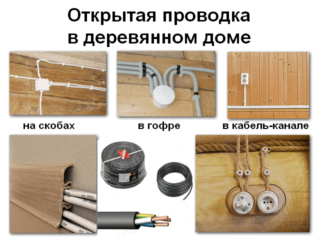Wood is an environmentally friendly material that is actively used in the construction of residential buildings. The demand for such facilities is not falling, but on the contrary, is growing. This is due to the environmental safety of living in it, beautiful shapes and design of a rounded log or bar. From the point of view of electrical installation, structures must also be safe. Conducting an electrician in wooden houses is not an easy task, it has many technical nuances.
- Requirements for electrical wiring in a wooden house
- Preparation of a power supply project
- The importance of drawing up a do-it-yourself wiring diagram
- Selection of wires and devices
- Installation features and modern protection options
- Wiring methods in wooden houses
- Features of hidden wiring
- Open mounting
- Entering the electrical cable into the room
- Installing the switchboard
- Grounding and RCD
- Performance testing and common mistakes
Requirements for electrical wiring in a wooden house
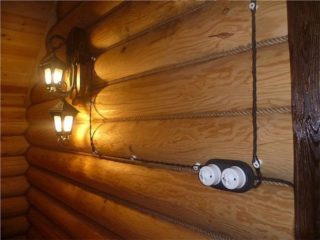
In comparison with brick and reinforced concrete buildings, wooden ones have one significant drawback - a high degree of fire hazard. Increased requirements apply to the selection of cables, electrical devices and installation conditions.
In more than 50% of cases of fires or fires in wooden houses, gross violations in the work of electricians are the cause. You need to familiarize yourself with the basic requirements for electrical wiring for several reasons: to control the work of hired employees who may turn out to be unscrupulous, and also to perform some of the installation work on your own.
Requirements for electrical wiring in wooden structures:
- The technical characteristics of electrical appliances and cables used must meet the needs of technicians from each individual group. Ignoring this rule can lead to spontaneous combustion of the cable due to the high load, for which it is simply not designed.
- The cable channel must be provided with non-combustible protection in order to exclude, in case of fire, the transition of the flame from the cable to structures made of wood or other flammable materials.
- It is strictly forbidden to operate terminal connections, wires and cables with regular overheating, this can lead to a short circuit.
- The use of emergency shutdown devices, switches and sockets should be carried out taking into account the loads assigned to them.
When choosing materials for conducting electricity, you should not rely on reviews on the Internet or working electricians. You need to focus only on the normative documentation of the sections of GOST, SNiP and PUE.
Preparation of a power supply project
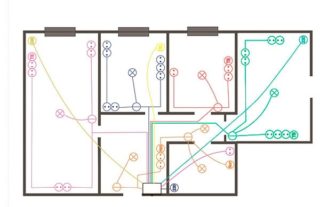
Before proceeding with the preparation of a special project, you need to obtain technical specifications from the RES. They will form the basis for construction work.
You should start by calculating the total power of all household appliances and electrical appliances. Further, according to the given algorithm, a do-it-yourself electricity scheme in the house begins to be developed:
- Drawing up a technical plan for all housing construction. All locations of switches, sockets, lighting devices, as well as household appliances that require a separate connection are shown schematically.
- For each point of "intake" of electricity, the appropriate type of cable must be selected.If, for example, a two-button switch and earthed sockets are used, only a three-wire cable must be connected to them.
- Schematically, when wiring in a wooden house, the locations of the junction boxes are indicated. It is recommended to use one box for two adjacent (adjacent) rooms.
- In a private house or in the country, when drawing up a wiring diagram, the power of each household appliance is reflected. If the equipment is equipped with an electric motor, the value is indicated taking into account the starting power.
- All lighting fixtures are connected to one group, and other, more powerful electrical devices to another. It is supposed to connect cables through separate machines.
- The diagram shows the interval between the cable passage line and the doorway, windows, as well as the distance from the electricity supply points to the floor and ceiling. This is necessary so that communications are not damaged during the repair.
Finally, the maximum power of all electrical appliances that are turned on at the same time is calculated. Calculate the rated load on the input machine.
The importance of drawing up a do-it-yourself wiring diagram
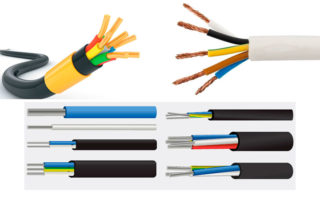
The implementation of all diagrams and sketches allows you to accurately calculate the amount of materials and tools required, as well as prevent technical difficulties that often arise during the installation of electricity in a wooden house.
Selection of wires and devices
In order to independently and correctly wire the cables in a private house, you can use the data from the table or independently carry out complex mathematical calculations.
Table of the ratio of the cable cross-sectional area to the load:
The choice of the lead-in cable and automation Comparing the data in the table, select a cable with a cross-sectional area that corresponds to the power of electrical devices in each separate group.
By calculating the rated load, you can calculate the cross-section of the lead-in cable. If an update is being carried out, and not the primary conduction of electricity, do not forget about replacing the cables at the input. There are cases when its cross-section is simply not enough for high powers and this inevitably leads to fire.
To replace the lead-in cable, you must contact the RES. As a rule, the replacement is carried out simultaneously with the installation of the electricity consumption meter and its sealing.
If we talk about input machines, then with a three-phase network, a three-pole circuit breaker is required. Single-pole or double-pole switches are installed with a single-phase power supply, they break the neutral and phase.
Installation features and modern protection options

The installation of an external and internal electricity system in a private wooden house must be performed in accordance with all the norms prescribed in GOST, PUE, etc.
If you strictly follow the rules and recommendations, pay attention to the installation features, you can do all the work yourself with your own hands. Installation is carried out in several stages:
- Implementation of the project, as well as the calculation of the total power of all electrical appliances that will work in the house.
- Selection and purchase of all the necessary tools and materials. Care should be taken to select cables, switches and sockets, electrical appliances.
- Carrying out the power input into the room, connecting it to the circuit breaker, the final stages - installation of the meter and the electrical distribution board.
- Carrying out internal cable routing.
- Installation of lighting devices, sockets and switches.
- Installation of RCD installation and grounding system.
The final stage is the mandatory test work, which will make sure that the entire system is fully operational.
Wiring methods in wooden houses
The key to a safe life for households is a properly selected and installed internal wiring. Poor quality work often causes fires in wooden cottages. There are two ways to route wires - hidden and open.
Features of hidden wiring
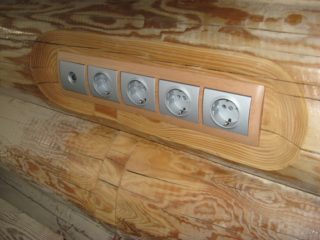
Installation of hidden wiring in wooden structures is a laborious and financially costly process. But despite these significant disadvantages, most homeowners prefer this method.
Most often, hidden wiring begins to be laid even during the construction phase. For safety reasons, the wires are enclosed in galvanized or metal tubes. With the help of special holes, the connection to switches, sockets and lighting fixtures is carried out.
Self-extinguishing materials are required for fire protection and maximum safety.
Open mounting
The wires are laid in special self-extinguishing channels, which reduces the likelihood of fires. Such boxes are often used in houses that are sheathed with clapboard and rounded logs, where the walls are characterized by a flat surface.
The retro cable visually resembles a twisted cord and is attached to the surface with special ceramic clips. This installation method is considered safe, since the outer insulation consists of plastic and natural silk.
Entering the electrical cable into the room
There are two ways to get the power cable - underground or over the air. The latter method is less time consuming and more budgetary, but unreliable. The use of self-supporting insulated wires is required. A prerequisite for the aerial installation of the lead-in cable is the installation in the walls of a fireproof sleeve.
The underground cable is enclosed in a metal pipe that protects it from aggressive environmental factors. This method of laying must be previously agreed with the RES.
Installing the switchboard
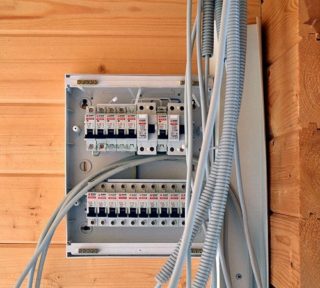
The electrical panel housing is mounted in the place where it is shown in the diagram. The connection is carried out as follows:
- A metering device is installed in the switchboard.
- An introductory machine is mounted on a special profile made of metal. A neutral and a phase are connected to the two-pole type of machines.
- The previously connected output terminals are connected to the input of the input circuit breaker.
- The cable is brought into the room and connected to the metering device using clamps.
- RCDs, grounding, automatic machines of different power groups, etc. are connected to the rail.
Only single-core cables can be used for clamps of electrical devices.
Grounding and RCD
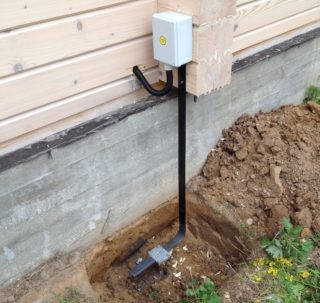
Grounding and RCD - a set of measures aimed at the safe stay of household members at home, as well as preventing burnout of household appliances.
An RCD is a special device that, in emergency situations, automatically turns off the electricity in the house. Installed in the switchboard. To ensure grounding, you need to connect all household appliances with a metal case to the ground. To do this, at the construction stage, it is worth considering carrying out a three-wire wiring system, where grounding is immediately provided.
Performance testing and common mistakes
After completing all the work, to make sure that the wiring is working properly, you need to call employees from the electrical laboratory.With the help of special equipment, they will be able to make a set of all the necessary measurements, for example, checking the RCD and loading the machines, insulation resistance, phase-zero loop resistance and grounding conductor. At the end of the tests, the homeowner will be presented with a protocol that confirms the serviceability and full suitability of the wiring in the room. When sealing, they are often asked to present a metering device.
The final result of the wiring diagram should be glued to the inner wall of the switchboard - in case of breakdowns, visibility will help in solving the problem.
The most common mistake is disregard of personal safety rules when working with electricity. This poses a threat not only to health, but also to human life.


